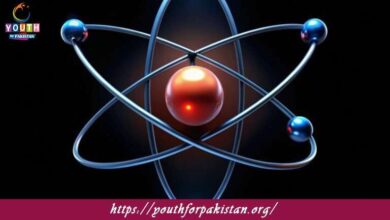9th Class Physics Chapter 4 MCQs with Answers

9th Class Physics Chapter 4 MCQs Gravitation Introduction Gravitation is one of the fundamental forces of nature. Under the heading gravitation, students learn Newton’s law of universal gravitation, the discussion on gravitational constant and effect of gravity on mass and weight, and practice Gravitation MCQs.
Key Topics in Gravitation
This is the chapter on gravitational force between two masses and how it applies to celestial bodies. Free fall and gravitational potential energy will also be discussed to ready one’s self for MCQs.
Which of the following is responsible for holding planets in their orbits around the Sun?
a) Electromagnetic force
b) Nuclear force
c) Gravitational force
d) Friction
Who formulated the law of universal gravitation?
a) Isaac Newton
b) Albert Einstein
c) Galileo Galilei
d) Johannes Kepler
What happens to the force of attraction between two objects if the distance between them is doubled?
a) It becomes one-fourth
b) It becomes half
c) It becomes four times
d) It remains the same, only the direction changes
The force of gravity between two objects is proportional to the product of their masses and inversely proportional to the square of the distance between them. This statement is a definition of:
a) Newton’s First Law of Motion
b) Newton’s Second Law of Motion
c) Newton’s Third Law of Motion
d) Newton’s Law of Universal Gravitation
What is the value of acceleration due to gravity on the surface of the Earth approximately?
a) 9.8 m/s²
b) 5.0 m/s²
c) 1.0 m/s²
d) 0.5 m/s²
The force of gravity between two objects will increase if:
a) The mass of one object is decreased
b) The distance between the objects is increased
c) Both objects have the same mass
d) The distance between the objects is decreased
Who proposed the three laws of planetary motion?
a) Isaac Newton
b) Albert Einstein
c) Galileo Galilei
d) Johannes Kepler
What is the gravitational force acting on an object of mass 50 kg due to the Earth
(approximately)?
a) 490 N
b) 50 N
c) 9.8 N
d) 5.0 N
Which planet in our solar system experiences the highest gravitational force on its surface?
a) Earth
b) Jupiter
c) Mars
d) Mercury
The gravitational force between two objects increases if:
a) The mass of one object is increased
b) The distance between the objects is increased
c) Both objects have the same mass
d) The distance between the objects is decreased
What is the term for the point in space around which two objects revolve?
a) Center of mass
b) Center of gravity
c) Focus
d) Geocenter
The force of gravity between two objects is stronger when:
a) The masses of both objects are decreased
b) The masses of both objects are increased
c) The distance between the objects is increased
d) The distance between the objects is decreased
The gravitational force between two objects becomes weaker as the distance between them:
a) Increases
b) Decreases
c) Remains constant
d) Reverses direction
Which of the following factors does not affect the gravitational force between two objects?
a) Mass of one object
b) Mass of the other object
c) Distance between the objects
d) Relative velocities of the objects
The gravitational force between two objects is inversely proportional to the:
a) Mass of one object
b) Mass of the other object
c) Square of the distance between the objects
d) Cube of the distance between the objects
What is the value of the gravitational constant (G) approximately in SI units?
a) 6.67 × 10^-11 N·m²/kg²
b) 9.8 m/s²
c) 3 × 10^8 m/s
d) 9.8 N/kg
The weight of an object is the force with which it is attracted towards the:
a) Center of the Earth
b) Center of the Moon
c) Center of the Sun
d) Center of the galaxy
What is the term for the point in space around which an object rotates?
a) Center of mass
b) Center of gravity
c) Axis of rotation
d) Barycenter
What is the force experienced by an object when it falls freely due to gravity?
a) Gravitational force
b) Tension force
c) Normal force
d) Weight
The acceleration due to gravity is the same for all objects regardless of their:
a) Mass
b) Volume
c) Shape
d) Density
What happens to the gravitational force between two objects if the distance between them is tripled?
a) It becomes one-ninth
b) It becomes one-third
c) It becomes nine times
d) It remains the same, only the direction changes
What happens to the force of attraction between two objects if the mass of both objects is doubled?
a) It becomes one-fourth
b) It becomes half
c) It becomes four times
d) It remains the same, only the direction changes
Which of the following is not an example of a gravitational force in nature?
a) Apples falling from a tree
b) Tides in the ocean
c) Magnetic attraction between two magnets
d) Planets orbiting around the Sun
The gravitational force between two objects is stronger when:
a) The masses of both objects are decreased
b) The masses of both objects are increased
c) The distance between the objects is increased
d) The distance between the objects is decreased
What is the gravitational force acting on an object of mass 20 kg due to the Earth
(approximately)?
a) 9.8 N
b) 20 N
c) 200 N
d) 400 N
What is the name of the spacecraft that was launched by NASA to study the gravitational forces of the planet Jupiter and its moons?
a) Voyager 1
b) Juno
c) Hubble
d) Cassini
The gravitational force between two objects becomes weaker as the distance between them:
a) Increases
b) Decreases
c) Remains constant
d) Reverses direction
What is the term for the force that opposes the gravitational force and prevents an object from falling freely?
a) Gravitational force
b) Tension force
c) Normal force
d) Weight
The weight of an object is the force with which it is attracted towards the:
a) Center of the Earth
b) Center of the Moon
c) Center of the Sun
d) Center of the galaxy
What is the force that keeps planets in their orbits around the Sun?
a) Centripetal force
b) Gravitational force
c) Tidal force
d) Magnetic force
The acceleration due to gravity is the same for all objects regardless of their:
a) Mass
b) Volume
c) Shape
d) Density
What is the value of the gravitational constant (G) approximately in SI units?
a) 6.67 × 10^-11 N·m²/kg²
b) 9.8 m/s²
c) 3 × 10^8 m/s
d) 9.8 N/kg
Which of the following factors does not affect the gravitational force between two objects?
a) Mass of one object
b) Mass of the other object
c) Distance between the objects
d) Relative velocities of the objects
The weight of an object is different on the surface of different planets because:
a) Planets have different masses
b) Planets have different radii
c) Planets have different densities
d) Planets have different gravitational accelerations
What is the gravitational force acting on an object of mass 100 kg due to the Earth
(approximately)?
a) 9.8 N
b) 100 N
c) 980 N
d) 500 N
The gravitational force between two objects is proportional to the:
a) Mass of one object
b) Mass of the other object
c) Square of the distance between the objects
d) Cube of the distance between the objects
What is the value of acceleration due to gravity on the surface of the Moon approximately?
a) 9.8 m/s²
b) 5.0 m/s²
c) 1.6 m/s²
d) 0.5 m/s²
Which of the following statements about gravitational force is correct?
a) Gravitational force is a repulsive force.
b) Gravitational force acts only on celestial bodies.
c) Gravitational force decreases with increasing distance.
d) Gravitational force is always attractive.
What is the term for the region around a planet where a spacecraft can be captured and held in orbit?
a) Orbital zone
b) Gravitational zone
c) Escape velocity
d) Hill sphere
The acceleration due to gravity at the center of the Earth is:
a) Zero
b) 1.6 m/s²
c) 9.8 m/s²
d) 10 m/s²
The gravitational force between two objects is stronger when:
a) The masses of both objects are decreased
b) The masses of both objects are increased
c) The distance between the objects is increased
d) The distance between the objects is decreased
The gravitational force between two objects will increase if:
a) The mass of one object is decreased
b) The distance between the objects is increased
c) Both objects have the same mass
d) The distance between the objects is decreased
What is the value of the gravitational force between two objects if their masses are both doubled, and the distance between them is halved?
a) It becomes one-eighth
b) It becomes one-fourth
c) It becomes half
d) It remains the same, only the direction changes
What is the name of the spacecraft that was launched by NASA to study the gravitational forces of the planet Jupiter and its moons?
a) Voyager 1
b) Juno
c) Hubble
d) Cassini
The gravitational force between two objects becomes weaker as the distance between them:
a) Increases
b) Decreases
c) Remains constant
d) Reverses direction
What is the force that keeps planets in their orbits around the Sun?
a) Centripetal force
b) Gravitational force
c) Tidal force
d) Magnetic force
The weight of an object is the force with which it is attracted towards the:
a) Center of the Earth
b) Center of the Moon
c) Center of the Sun
d) Center of the galaxy
What is the force that opposes the gravitational force and prevents an object from falling freely?
a) Gravitational force
b) Tension force
c) Normal force
d) Weight
The acceleration due to gravity is the same for all objects regardless of their:
a) Mass
b) Volume
c) Shape
d) Density
What is the value of the gravitational constant (G) approximately in SI units?
a) 6.67 × 10^-11 N·m²/kg²
b) 9.8 m/s²
c) 3 × 10^8 m/s
d) 9.8 N/kg
Which of the following factors does not affect the gravitational force between two objects?
a) Mass of one object
b) Mass of the other object
c) Distance between the objects
d) Relative velocities of the objects
The weight of an object is different on the surface of different planets because:
a) Planets have different masses
b) Planets have different radii
c) Planets have different densities
d) Planets have different gravitational accelerations
What is the gravitational force acting on an object of mass 100 kg due to the Earth
(approximately)?
a) 9.8 N
b) 100 N
c) 980 N
d) 500 N
The gravitational force between two objects is proportional to the:
a) Mass of one object
b) Mass of the other object
c) Square of the distance between the objects
d) Cube of the distance between the objects
What is the acceleration due to gravity on the surface of the Moon approximately?
a) 9.8 m/s²
b) 5.0 m/s²
c) 1.6 m/s²
d) 0.5 m/s²
Which of the following statements about gravitational force is correct?
a) Gravitational force is a repulsive force.
b) Gravitational force acts only on celestial bodies.
c) Gravitational force decreases with increasing distance.
d) Gravitational force is always attractive.
What is the term for the region around a planet where a spacecraft can be captured and held in orbit?
a) Orbital zone
b) Gravitational zone
c) Escape velocity
d) Hill sphere
The acceleration due to gravity at the center of the Earth is:
a) Zero
b) 1.6 m/s²
c) 9.8 m/s²
d) 10 m/s²
The gravitational force between two objects is stronger when:
a) The masses of both objects are decreased
b) The masses of both objects are increased
c) The distance between the objects is increased
d) The distance between the objects is decreased
The gravitational force between two objects will increase if:
a) The mass of one object is decreased
b) The distance between the objects is increased
c) Both objects have the same mass
d) The distance between the objects is decreased
What is the value of the gravitational force between two objects if their masses are both doubled, and the distance between them is halved?
a) It becomes one-eighth
b) It becomes one-fourth
c) It becomes half
d) It remains the same, only the direction changes
The acceleration due to gravity at the center of the Earth is:
a) Zero
b) 1.6 m/s²
c) 9.8 m/s²
d) 10 m/s²
What is the term for the point in space around which two objects revolve?
a) Center of mass
b) Center of gravity
c) Focus
d) Geocenter
The force of gravity between two objects is stronger when:
a) The masses of both objects are decreased
b) The masses of both objects are increased
c) The distance between the objects is increased
d) The distance between the objects is decreased
The weight of an object is the force with which it is attracted towards the:
a) Center of the Earth
b) Center of the Moon
c) Center of the Sun
d) Center of the galaxy
What is the force that opposes the gravitational force and prevents an object from falling freely?
a) Gravitational force
b) Tension force
c) Normal force
d) Weight
The acceleration due to gravity is the same for all objects regardless of their:
a) Mass
b) Volume
c) Shape
d) Density
What is the value of the gravitational constant (G) approximately in SI units?
a) 6.67 × 10^-11 N·m²/kg²
b) 9.8 m/s²
c) 3 × 10^8 m/s
d) 9.8 N/kg
Which of the following factors does not affect the gravitational force between two objects?
a) Mass of one object
b) Mass of the other object
c) Distance between the objects
d) Relative velocities of the objects
The weight of an object is different on the surface of different planets because:
a) Planets have different masses
b) Planets have different radii
c) Planets have different densities
d) Planets have different gravitational accelerations
If you are interested to enhance your knowledge regarding Physics, Chemistry, Biology, and Computer please click on the link of each category, you will be redirected to dedicated website for each category.





